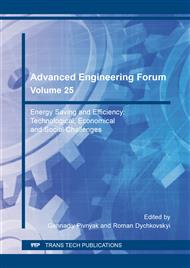[1]
Inglehart, R. (1971), The Silent Revolution in Post-Industrial Societies, American Political Science Review, Vol. 65, p.991—1017.
DOI: 10.2307/1953494
Google Scholar
[2]
Maslow, А. (1987), Motivation and Personality, third ed., Addison-Wesley, New York, U.S. A.
Google Scholar
[3]
Planck, M. (1945), Treatise on Thermodynamics, third ed., Dover, New York, U.S. A.
Google Scholar
[4]
Penrose, R. (2014), The Emperor's New Mind Publisher, Oxford University Press, New York, U.S. A.
Google Scholar
[5]
Bohr, N., (2010), Atomic Physics and Human Knowledge, Cambridge University Press, New York, U.S. A.
Google Scholar
[6]
Hameroff, S. and Penrose, R., (2014), Consciousness in the universe: A review of the 'Orch OR' theory, Physics of Life Reviews. Vol. 11 (1), p.39–78.
DOI: 10.1016/j.plrev.2013.11.013
Google Scholar
[7]
Herbert, N., (1993), Elemental mind: human consciousness and the new physics, Harper & Row, New York, U.S. A.
Google Scholar
[8]
Uspenskij, P. D. (1992), Tertium organum. Kljuch k zagadkam mira [Tertium organum. The key to the riddles of the world], izdatel'stvo: Andreev i Synov'ja, Sankt Peterburg, Rossija.
Google Scholar
[9]
Struminskij, V.V. (1997). Kak i dlja chego voznikla zhizn' na zemle i planetah kosmosa, [How and for what there was a life on the earth and planets], Visnyk NAN Ukrainy Vol. 1-2, p.80 – 87.
Google Scholar
[10]
Volchenko, V.N. (1997). Prinjatie Tvorca sovremennoj naukoj" [Modern science accepts the Creator], Soznanie i fizicheskaja real'nost,. vol. 2. p.11– 27.
Google Scholar
[11]
The website of the Campaign for Open Science, (2014), Manifesto for a Post-Materialist Science, available at: http: /www. opensciences. org/about/manifesto-for-a-post-materialist-science (Accessed 9 February 2014).
Google Scholar
[12]
Schwartz, G. (2015), Super Mind: The self-science of synchronicity and divine timing in daily life. Param Media, Vancouver, Canadian.
Google Scholar
[13]
Santos, F. S. (2012), Exploring Frontiers of the Mind-Brain Relationship. Springer, New York, U.S. A.
Google Scholar
[14]
Nicshe, F. (2005). Volja k vlasti. Opyt pereocenki vseh cennostej [The will to power. Experience of revaluation of all values], Kul'turnaja revoljucija, Moskva, Rossija.
Google Scholar
[15]
Mol', A. (1973). Sociodinamika kul'tury. [Socio-dynamics of culture], Progress, Moskva, Rossija.
Google Scholar
[16]
Blavatskaja, E.P. (1992), Tajnaja doktrina [The secret doctrine ], vol. 1, Progress-Siring, Moskva, Rossija.
Google Scholar
[17]
Zhuravljov, V. I. (1999), Sovremennoe miroponimanie. [The modern view of the world ], Tornado, Doneck, Ukraina.
Google Scholar
[18]
Shabanova, Ju. A. (2013), Sovremennaja filosofija v voproshanii celostnosti, [Modern philosophy in search of wholeness], Praktychna filosofiia, vol. 3, pp.184-190.
Google Scholar
[19]
Karter, B. (1978), Kosmologija. Teorija i nabljudenie. [Cosmology. Theory and observation], Mir, Moskva, Rossija.
Google Scholar
[20]
Prigozhin, I. and Stengers I., (1986), Porjadok iz haosa: Novyj dialog cheloveka s prirodoj. [Order from chaos: A new dialogue between man and nature] Progress, Moskva, Rossija.
Google Scholar
[21]
Prigunov, A.S. (2012), Sovremennoe miroponimanie. Teosofija i nauka. [Modern understanding of the world. Theosophy and science], Izdatel'stvo Gornogo universiteta, Dnepropetrovsk, Ukraina.
Google Scholar
[22]
Feynman, R. (1964), The Feynman Lectures on Physics. California Institute of Technology, New York, U.S. A.
Google Scholar
[23]
Hanceverov, F.R. (1996), Jeniologija. [Eniology], vol. 1, ANM, Moskva, Rossija.
Google Scholar
[24]
Shvebs, G.I. (2002), Kratkij jenciklopedicheskij slovar' po jeniologii. [Short encyclopedic Eniologic dictionary], Jenio, Odessa, Ukraina.
Google Scholar
[25]
Shabanova, Yu.O. (2015), Systemnyj pidkhid u vyschyj shkoli. [System approach in higher education], Vydavnytstvo Hirnychoho universytetu, Dnipropetrovs'k, Ukraina.
Google Scholar
[26]
Ohatrin, A.F. (1989), Mikroklastery i sverhlegkie chasticy. [Microclusters and ultralight particles ], Znanie. Moskva. Rossija.
Google Scholar
[27]
Dmitriev, A.N. (1995), Mahatmy i nauka o novyh kachestvah Solnechnoj Sistemy [Mahatmas and the science of the new qualities of the Solar System], Znamja mira, Tomsk, Rossija.
Google Scholar
[28]
Struminskij, V.V. (1997), Kak i dlja chego voznikla zhizn' na zemle i planetah kosmosa, [How and for what there was a life on the earth and planets of space], Visnyk NAN Ukrainy. vol. 1-2. p.80 – 87.
Google Scholar
[29]
Shipov, G.I. (1993), Teorija fizicheskogo vakuuma. [Theory of physical vacuum], Naukа, Moskva. Rossija.
Google Scholar


